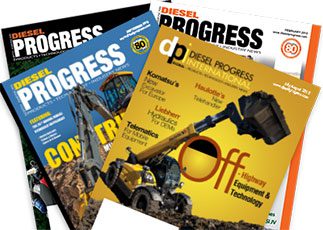Mike Brezonick, Diesel Progress Editor-in-Chief, explains what end-users want from their engine-powered equipment, and how dealers can strengthen relationships with their customers through service.
Advancing technologies and sensors built in equipment are shifting how manufacturers, dealers, and end-users interact with machines. Perhaps, the greatest shift has taken place in the engine-powered equipment industry. Power equipment manufacturers need to consider evolving environmental and fuel standards and equipment performance in addition to improving their response to urgent maintenance and repair issues.

“We like to think of ourselves as the news service of the equipment industry,” said Mike. “Some people have even referred to us as the Washington Post of the industry.”
With the opportunity to speak with such a respected voice in the industry, I wanted to learn:
Why is service such an important factor for businesses using engine powered equipment?
Service, Mike highlighted, is a key ingredient to equipment end-user success. Unscheduled equipment downtime can cost tens or even hundreds of thousands of dollars. With that kind of money on the line, contractors are no longer tolerating unscheduled equipment downtime. They’re looking for an equipment partner, someone they can trust to keep their machines up and running at all times.
“The difference between this kind of equipment [heavy power equipment] and, let’s say an automobile, is if your automobile isn’t working, you’re inconvenienced. If your wheel loader isn’t working, you’re losing money every hour it’s down.”
Businesses can accommodate scheduled downtime because they can substitute a down piece of equipment with a functioning one or postpone a job until their fleet is fully functioning. But unscheduled downtime, as Mike illustrates, can be extremely costly.
“That’s why service is so important now. You have to get service personnel the right knowledge and the right service parts. Get them where they need to be as soon as possible and get the machine back running. It’s of critical importance.”
How are equipment manufacturers taking advantage of their customers’ demand for strong service?
Service isn’t anything new for engine-powered equipment manufacturers. It’s always been a big part of the business, and it’s why a lot of the most successful companies have been successful.
Contractors aren’t evaluating machine performance and capabilities as much because they’re realizing that from brand to brand, the equipment isn’t that different. It’s all good. What separates manufacturers is the experience the dealer is able to provide on the service side. Customers want assurance that there will be someone there, prepared to fix their equipment should something go wrong.
Mike uses Caterpillar as an example of an equipment manufacturer taking advantage of strong service initiatives:
“One of the reasons Caterpillar is so strong is their dealer network is very good at supporting customers in the field. If I’m buying a wheel loader or excavator or haul truck, I feel good about buying equipment from a company like that because I know somebody can be there within the hour to help me get my machine back to where it’s making me money.”
Good dealers have always offered their partnership. “When you buy a Caterpillar machine, you also buy the dealer.”
What technologies are equipment manufacturers building into their machines to improve service performance?
Recently, equipment manufacturers have had to pay closer attention to new and changing fuel and emissions standards. Engine emissions have always been a critical concern, but recent changes with Tier 4 and now Tier 5 have required that manufacturers adjust aspects on all parts of the machine including different cooling packages, control systems, and hydraulics.
Essentially everything that goes into the machine impacts emissions. The cost of these changes is significant. For many engine-powered equipment manufacturers, ¾ of the entire engineering budget has been devoted to improving engine emissions.
As those changes to meet emissions regulations become more standard, the cost will go down and manufacturers will have more a larger budget for forward-thinking technologies like telematics, diagnostics, and sensors to connect machine-to-machine, machine-to-manufacturer, machine-to-dealer, and machine-to-customer.
- Key technology trends impacting the power equipment industry: Telematics, connected machines, and diagnostics
Diagnostics technologies have signaled a huge change for equipment service organizations and the level of effectiveness with which they can resolve machine problems.
It’s easier now for service personnel to troubleshoot equipment than it’s ever been before. Today’s sophisticated systems literally tell you in plain English what you need to look at.
“Back in the day,” said Mike, “if it wasn’t working right, you opened it up, looked at it, listened to it, and did the diagnosing that way. Now you just plug this thing into the machine, run these diagnostics, and say, ‘ok, it’s that.’”
In addition to improved diagnostics capabilities, we’re also seeing an increase of connected equipment through telematics.
One manufacturer was talking about his system, which is set up so that when there’s a problem, the dealer knows about it immediately. And when he dispatches his service personnel to work on a problem, he’s aware of what the problem is so he can schedule someone with the right skills and parts and know approximately how long it will take to fix.
“It’s impressive because when you stop and think, the physical equipment itself is impressive in what it can do on a jobsite. But then you think of all the intelligence that’s in that machine that makes it work in a really efficient manner. If there are any problems, it alerts the operator. If the emissions system or any other piece isn’t working right, the operator is aware of it. It’s a remarkable change – we’ve gone from bottle rockets to the space shuttle. I can see the day when virtually all machines will be connected somehow.”
What are dealers doing with the influx of telematics data?
Built in sensors and telematics data offer equipment users endless supplies of information about machine performance, efficiency, fuel consumption, and more. But someone needs to make sense of all the data in order for it to become actionable.
The problem is, the machine owner has a job to do beyond interpreting equipment information. He doesn’t want to waste time analyzing data, which puts dealers in an advantageous position to leverage that information.
To take pressure off their customers, dealers can provide data analytics as an additional service offering. As part of the agreement, dealers monitor everything for the customer and make sure equipment assets are kept in peak operating condition.
This is a great business opportunity for dealers because it gives them access to loyal customers long-term. They treat the service and analytics packages like customer care packages: “You buy my machine and my dealer will make sure that machine works all the time, whenever you need it.”
Conclusion – A Look into the Future of Machine Telematics for Engine-Powered Equipment
Clearly, engine -powered equipment manufacturers and dealers stand to gain a lot from improving product support and tightening the relationship with end-users. Advancing technologies will allow equipment manufacturers and dealers to perform remote diagnostics and give customers visibility into the state of their machine performance. As a result, equipment users will depend more on dealers’ in-depth machine analytics and skilled service and repair personnel to keep their equipment running at full force so they can finish their projects faster and more efficiently.
Get the Complete Buyer’s Guide to Mobile Field Service Software
To capitalize on service as a profit center, you need to empower your technicians with the tools to do it right. Learn what to look for in a mobile field service solution in this free guide. [para align=”left”]










